
Traders spend a lot of time learning strategies and reading the markets, but the way we think can be just as important as the tools we use. Fallacies are common thinking errors that lead us to bad decisions, even when we think we're being logical.
These mental traps can quietly influence how we interpret price movements, trends, and even our own trading performance. In this article, we’ll explore the most common fallacies traders face.
Fallacies are common thinking mistakes that seem logical at first but are actually based on faulty reasoning. They often show up in the way we process information, make assumptions, or try to predict outcomes when we’re under pressure.
In trading, fallacies can lead you to trust your instincts at the wrong time or act on patterns that aren’t really there. These moments usually happen after a win streak, during a fallback, or when the market feels unpredictable. The problem is, fallacies often sound reasonable, which makes them easy to believe and even easier to act on.
You can’t avoid all of them, but once you understand how they work, you can catch yourself before they start affecting your trades. It’s about staying objective, not on what your brain is trying to shortcut.
Even experienced traders can fall for mental shortcuts that seem logical but lead to poor decisions. These fallacies often creep in when emotions are high, confidence is shaky, or the market feels unpredictable.
Let’s go through the most common ones and see how they show up in real trading.
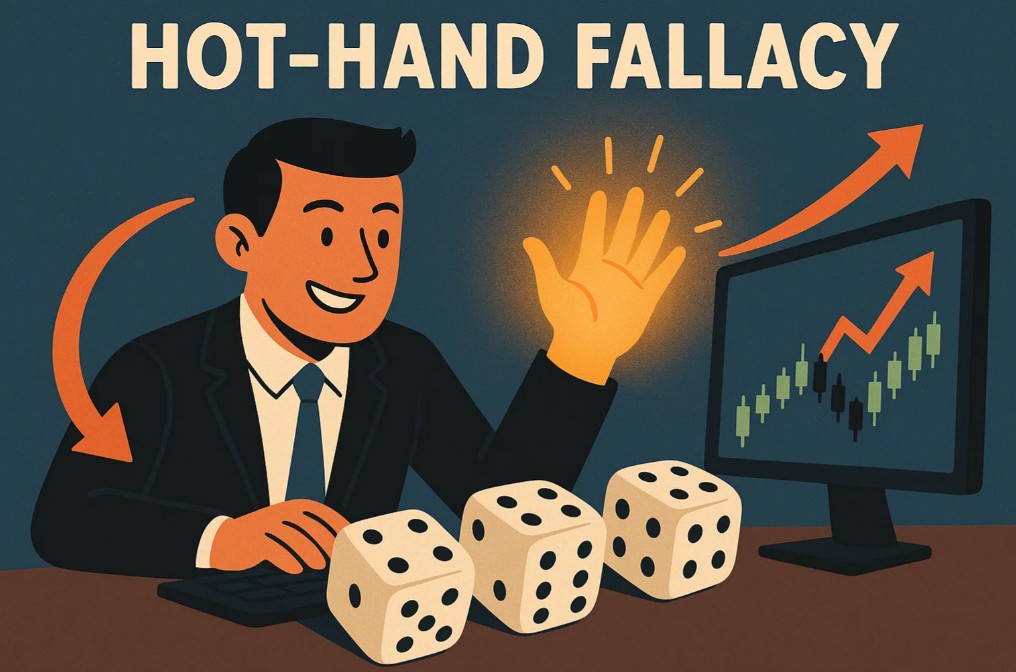
The hot-hand fallacy is the belief that after a series of successful trades, your next one is more likely to win just because you're "on a winning streak." It gives a false sense of momentum and leads to overconfidence.
Someone keeps rolling dice and hits a few high numbers in a row. They start to believe they have a special touch, even though each roll is random and has no connection to the last one.
In trading, this shows up when a trader has some successful transactions or profits and starts increasing position sizes. Also start skipping analysis, or trading more frequently. The feeling of being “in the zone” can push them into risky setups they’d normally avoid.
How to avoid:
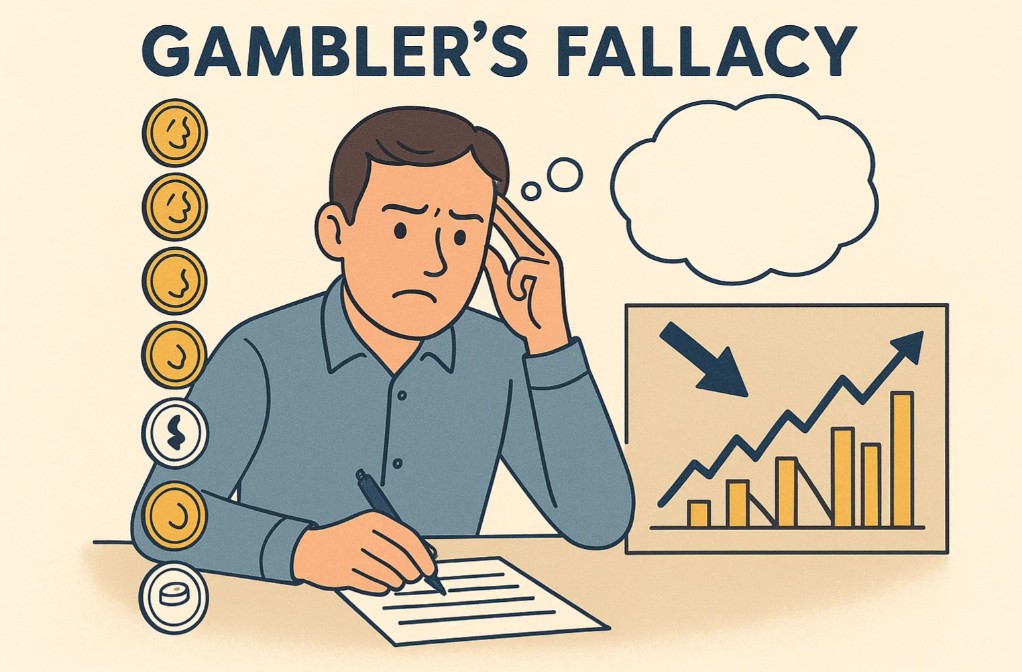
The gambler’s fallacy is the belief that if something keeps happening, it’s bound to reverse soon, even when each outcome is unrelated. It’s the classic “it can’t keep going like this” mindset.
Someone flips a coin five times and gets heads each time. They start to think tails is now overdue, even though the odds haven’t changed.
In trading, this often happens during strong trends. A trader sees a market rising for several sessions and assumes a drop must be coming, so they short too early. Or they avoid entering long trades because “it’s already gone too far.”
How to avoid:
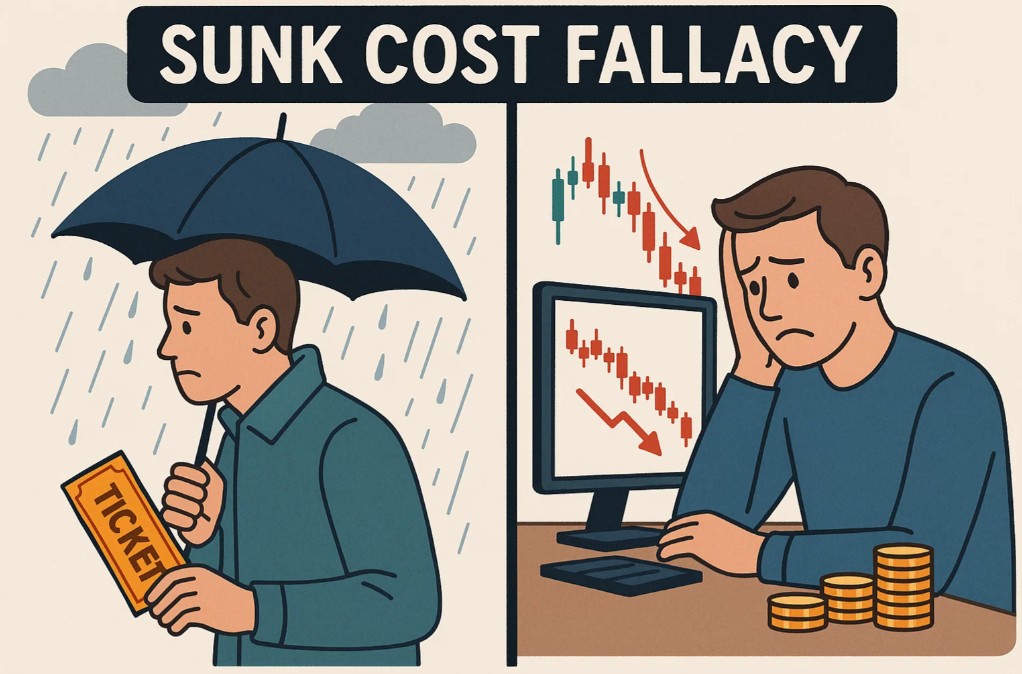
The sunk cost fallacy happens when traders stay in a bad position just because they’ve already invested time, money, or emotional energy into it. Instead of cutting the loss, they hold on, hoping things will turn around.
You buy tickets to an event, but on the day it rains heavily. Even though you don’t feel like going anymore, you still go because you already paid. You focus on what’s been spent instead of what’s best for you now.
In trading, this shows up when someone refuses to close a losing trade because “they’ve come this far.” Instead of reassessing the setup, they hang on out of pride or hope. And that can cause extra losses.
How to avoid:
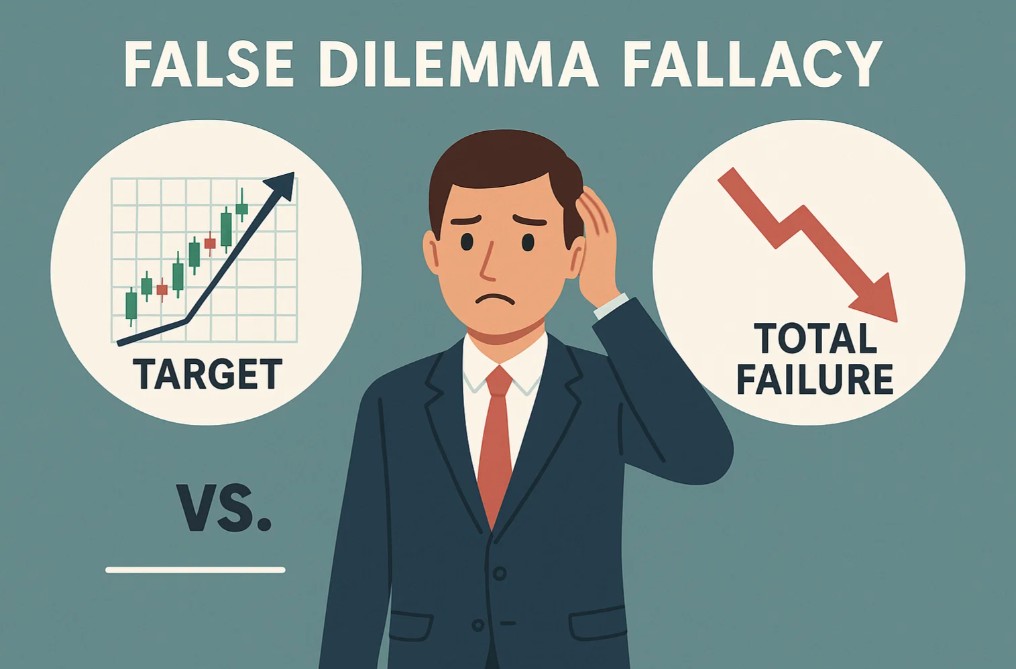
This fallacy shows up when traders believe there are only two possible outcomes, ignoring other possibilities. It turns complex situations into black-or-white thinking, which can limit noticing other options.
Someone might say, “Either I get this job or my career is over,” when in reality, there are many other paths they could take. The pressure comes from narrowing their focus too much.
In trading, a common example is thinking, “Either this trade hits my target, or it’s a total failure.” This type of thinking can lead to stubborn holding or all-or-nothing risk. It completely opts out other options like partial exits, adjusting stops, or simply standing aside.
How to avoid:
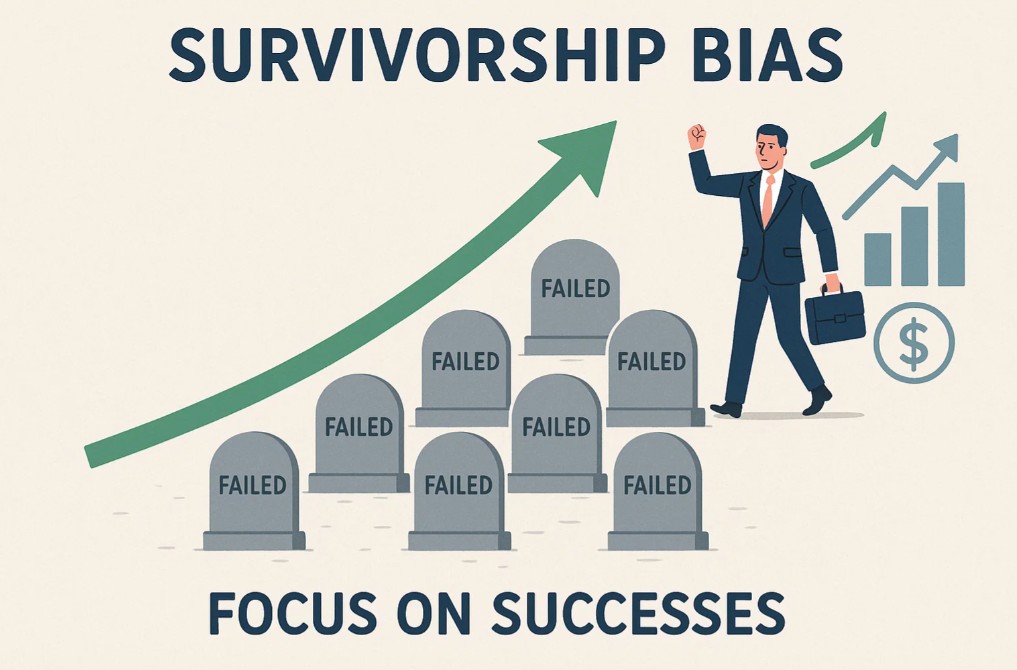
This bias happens when we focus only on the success stories that are still around and ignore the ones that failed and disappeared. It creates a false sense of what’s normal or achievable in trading.
You hear stories of startups that became billion-dollar companies, but no one talks much about the thousands that went broke trying. The spotlight only lands on the winners.
In trading, it’s easy to follow traders on social media who show big gains, or to copy strategies that worked well in backtests. But we rarely see the ones who failed using the same method, or the ones who blew their accounts and left the game.
How to avoid:
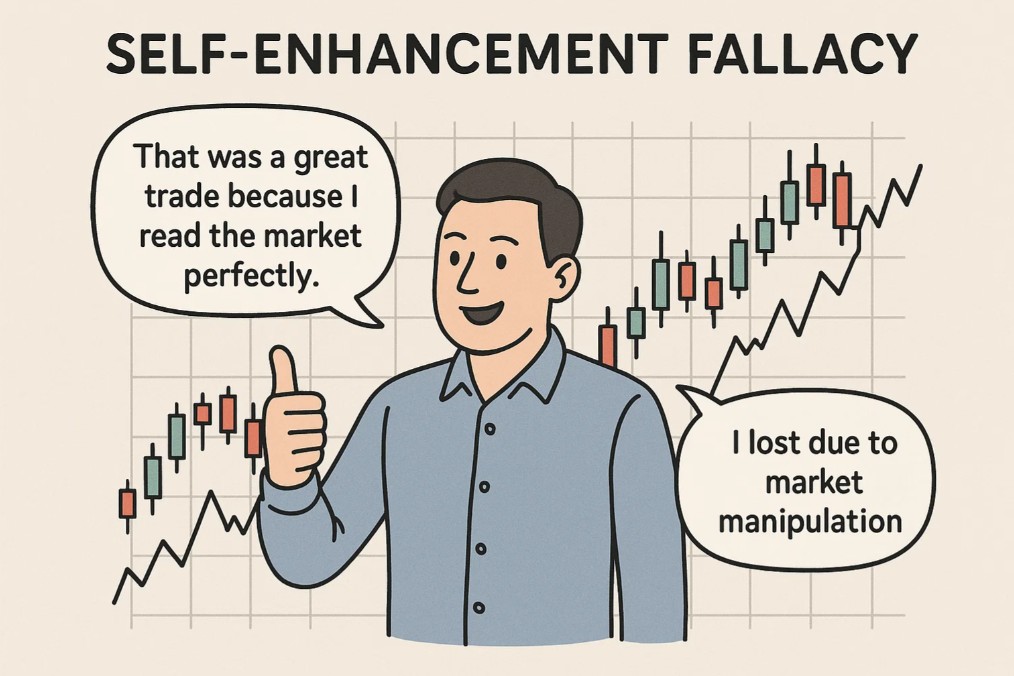
This fallacy shows up when traders give themselves too much credit for wins but blame outside factors for losses. It creates a distorted view of personal performance and slows down learning.
A student might say, “I passed because I’m smart,” but when they fail, they say, “The exam was unfair.” It’s an easy way to protect self-esteem, but it blocks real improvement.
In trading, this can look like saying “That was a great trade because I read the market perfectly,” but then blaming a loss on market manipulation, news events, or your broker. Over time, this mindset keeps you from seeing where your process needs work.
How to avoid:
Why do fallacies feel logical even when they’re not?
Because fallacies often rely on familiar patterns or emotional reasoning. They match how we want things to work, not how they actually do. That’s why they slip through so easily, especially when we’re under pressure.
Can fallacies affect how I choose a trading strategy?
Yes. You might overrate a strategy that performed well recently (recency effect) or follow a popular one because others are doing it (bandwagon thinking). Fallacies don’t just affect trade execution; they influence what you believe is worth trading in the first place.
How do I know if a fallacy is creeping into my decisions?
Start by listening to your own internal dialogue. If you’re justifying trades based on feelings like “it has to turn soon” or “I deserve a win,” that’s usually a sign. A good test is to ask: “Would I make the same call if I didn’t have any money on the line?”
Do fallacies get worse in high-volatility markets?
Definitely. When price moves are fast and emotions are high, we’re more likely to fall back on mental shortcuts. That’s when structured thinking breaks down, and fallacies sneak in unnoticed.
Can backtesting help reduce fallacy-driven trading?
Yes, if it’s done objectively. Backtesting forces you to follow a fixed set of rules and review outcomes without emotion. Just be careful not to overfit the strategy to past data or ignore outliers that don’t support your theory.
Is intuition always a bad thing in trading?
Not always. Intuition can be helpful if it’s built on years of pattern recognition and market experience. The danger is when intuition replaces structure, especially if it’s influenced by bias or emotional thinking.
Should I be worried if I keep repeating the same fallacy?
Not worried, but definitely aware. It’s common to fall into the same mental traps until you actively build habits to catch them. That’s why journaling and post-trade reviews are so valuable. Awareness isn’t enough. Action is what creates change.
Fallacies don’t always look like mistakes. They often feel like logic in the moment, which is what makes them so tricky. Whether it’s chasing a streak, refusing to close a bad trade, or believing something “has to happen,” these thinking traps can quietly pull your performance off track.
You don’t need to overanalyze every trade, but being aware of how your mind works under pressure gives you an edge most traders ignore. The goal isn’t perfection. It’s being consistent. And that starts with acting based on plans, not emotions.
 QuickTrade in cTrader: How to Place Trades Faster
QuickTrade in cTrader: How to Place Trades Faster
QuickTrade is a built-in cTrader feature that allows you to place trades directly from the chart, without opening the full order ticket.
Detail A Practical Guide to cBots on cTrader
A Practical Guide to cBots on cTrader
Discover cBots in the cTrader ecosystem, how they are added and used through cTrader Algo, and what to pay attention to when selecting a strategy.
Detail cTrader Shortcuts: 15 Tips to Upgrade Your Experience
cTrader Shortcuts: 15 Tips to Upgrade Your Experience
This guide highlights 15 practical shortcuts and settings that upgrade your cTrader experience.
DetailThen Join Our Telegram Channel and Subscribe Our Trading Signals Newsletter for Free!
Join Us On Telegram!